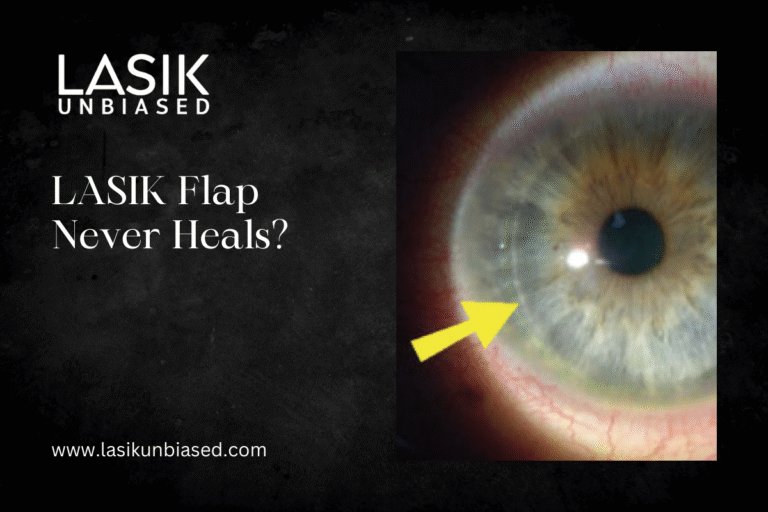No, the LASIK flap never fully heals in the same way natural tissue does. While it re-adheres over time and becomes highly stable, it remains a weak point compared to untouched corneal tissue.
It never forms the strong fibrous scar typical of other wounds but instead heals primarily by weak fibrous adhesion.
If you’re considering LASIK surgery or have already undergone it, understanding this key fact is crucial for protecting your vision and ensuring long-term eye health. This blog explores the science behind the LASIK flap, its healing process, and how to minimise risks after surgery.
What Is the LASIK Flap?
To understand why the LASIK flap never completely heals, it’s important to know what it is and how it’s created. During LASIK surgery, a thin flap is cut in the surface of the cornea, allowing the surgeon to reshape the underlying tissue with a laser. This flap is carefully folded back during the procedure and precisely repositioned upon the completion of the reshaping process.
The creation of this flap is what sets LASIK apart from other forms of vision correction surgery, like PRK (photorefractive keratectomy). While PRK removes the outer layer of the cornea entirely, LASIK leaves the tissue largely intact, resulting in faster healing and reduced discomfort. However, this surgical approach has its trade-offs, one of which is the fact that the flap never fully heals.
Why Doesn’t the LASIK Flap Fully Heal?
The Nature of Corneal Tissue
The cornea is a complex, multi-layered structure made mostly of collagen. Its unique organisation allows it to maintain transparency, protect the eye, and focus light effectively. However, this tightly arranged tissue does not regenerate scar-free like skin or muscle does.
When the LASIK flap is created, it disrupts the natural structure of the cornea. Although the flap begins to re-adhere to the rest of the cornea within hours of surgery, it does not regain its original structural integrity.
Lack of Cellular Regeneration
After surgery, the body’s healing response involves fibrous adhesion, not full cellular regeneration. This adhesion helps the flap stay in place securely, but it doesn’t form the same type of bond as uncut corneal tissue. Over time, this area remains mechanically weaker and can be prone to displacement under extreme stress.
Long-Term Stability vs Complete Healing
The corneal flap’s stability improves significantly over the first few weeks and months after surgery. Studies show that most flap adhesion strength develops within the first month, but it never reaches the original uncut tissue’s strength.
Most patients can resume normal activities shortly after LASIK because the risk of flap dislocation becomes very low. However, this does not mean the flap “heals” in the biological sense. Even years after surgery, trauma to the eye, such as a blow from a sporting accident, can dislodge the flap.
Risks Associated with the LASIK Flap
Flap Dislocation
Dislocation risk is highest in the first days to weeks after surgery, but can remain possible, though extremely rare, years later following significant trauma. For example, rubbing your eyes too aggressively within the first few days after surgery can dislodge the flap.
Even years later, high-impact activities like contact sports or accidents pose a minor risk. This is why LASIK patients are often advised to wear protective eyewear in certain situations.
Complications From Dry Eye
LASIK surgery can sever some of the nerves in the cornea, potentially leading to dry eye. This condition increases discomfort and can affect the quality of healing and vision after surgery, although it does not directly weaken the mechanical stability of the flap. Adequate lubrication and management of dry eye symptoms are important for maintaining overall eye health post-LASIK.
Epithelial Ingrowth
Epithelial cells can sometimes grow under the LASIK flap, causing symptoms like blurred vision, light sensitivity, or discomfort. While this complication is rare and more common in retreatments or trauma cases, it highlights the importance of regular follow-up visits with your ophthalmologist.
The Importance of Aftercare for Flap Stability
Immediate Postoperative Care
The first few days after LASIK are crucial for allowing your eyes to heal properly. Follow these tips:
- Don’t rub your eyes. Even gentle pressure can dislodge the flap during the early healing phase.
- Use prescribed medicated eye drops to prevent infection and inflammation.
- Wear protective shields at night to prevent accidental irritation during sleep.
Ongoing Maintenance
For long-term flap stability:
- Avoid high-risk activities without proper protective gear.
- Regularly see your eye doctor for exams, even if your vision seems fine.
- Protect your eyes from UV radiation, which can weaken the tissue over time.
Alternatives to LASIK for Enhanced Safety
If the idea of a permanently vulnerable corneal flap concerns you, there are alternative procedures to consider:
- PRK (Photorefractive Keratectomy): This surgery doesn’t create a corneal flap, reducing the risk of long-term complications. Healing from PRK takes longer, but the results are similar to LASIK.
- SMILE (Small Incision Lenticule Extraction): SMILE involves creating a small incision in the cornea instead of a flap, offering a safer option for some patients.
Both PRK and SMILE eliminate the need for a flap, reducing the risk of dislocation or related complications.
Can the LASIK Flap Affect Vision Long Term?
For the majority of patients, the LASIK flap does not adversely impact long-term vision. Advances in modern LASIK technology have established it as an exceptionally safe and effective procedure. However, understanding the unique characteristics of the flap and following proper aftercare can help you maintain optimal results for years to come.
Is LASIK Still a Good Choice?
For the majority of patients, the benefits of LASIK far outweigh the risks. The surgery offers life-changing improvements in vision, often eliminating the need for glasses or contact lenses. That said, being informed about the flap’s limitations is essential for making an educated decision.
If you participate in high-impact sports, have an occupation with a higher risk of eye trauma, or are simply concerned about the flap’s resilience, discussing alternative procedures with your ophthalmologist is a wise choice.
Safeguarding Your Vision for the Future
LASIK is a highly effective procedure, but it’s not without its complexities. While the flap never fully heals in a biological sense, it becomes stable enough for most daily activities and delivers excellent visual outcomes for millions of patients worldwide.
Understanding the science behind the LASIK flap empowers you to make better choices for your eye health and equips you with the knowledge to care for your vision effectively. If you’re considering LASIK or simply want to learn more about your eye health options, consult a qualified ophthalmologist who can guide you based on your unique needs.


